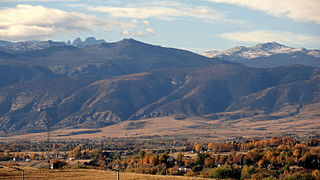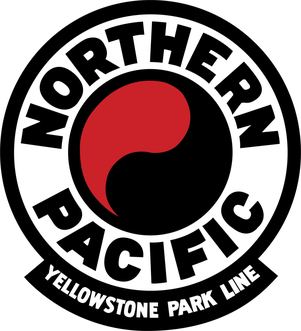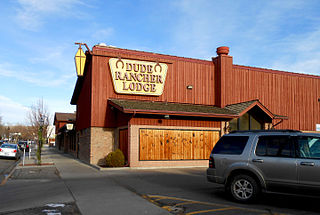Related Research Articles

Havre is the county seat and largest city in Hill County, Montana, United States. Havre is nicknamed the crown jewel of the Hi-Line. It is said to be named after the city of Le Havre in France. As of the 2020 census the population was 9,362.

Sheridan is a city in the U.S. state of Wyoming and the county seat of Sheridan County. The city is located halfway between Yellowstone Park and Mount Rushmore by U.S. Route 14 and 16. It is the principal town of the Sheridan, Wyoming, Micropolitan Statistical Area which encompasses all of Sheridan County. The 2020 census put the city's population at 18,737, making it the 6th most populous city in Wyoming.

The Northern Pacific Railway was an important transcontinental railroad that operated across the northern tier of the western United States, from Minnesota to the Pacific Northwest. It was approved and chartered in 1864 by the 38th Congress of the United States in the national / federal capital of Washington, D.C., during the last years of the American Civil War (1861-1865), and given nearly 40 million acres of adjacent land grants, which it used to raise additional money in Europe, for construction funding.
A guest ranch, also known as a dude ranch, is a type of ranch oriented towards visitors or tourism. It is considered a form of agrotourism.

Livingston, is a city and the county seat of Park County, Montana, United States. It is in southwestern Montana, on the Yellowstone River, north of Yellowstone National Park. As of the 2020 census, the population of the city was 8,040.

Cattle drives were a major economic activity in the 19th and early 20th century American West, particularly between 1850s and 1910s. In this period, 27 million cattle were driven from Texas to railheads in Kansas, for shipment to stockyards in St. Louis and points east, and direct to Chicago. The long distances covered, the need for periodic rests by riders and animals, and the establishment of railheads led to the development of "cow towns" across the frontier.

A train dispatcher (US), rail traffic controller (Canada), train controller (Australia), train service controller (Singapore) or signaller (UK), is employed by a railroad to direct and facilitate the movement of trains over an assigned territory, which is usually part, or all, of a railroad operating division. The dispatcher is also responsible for cost effective movement of trains and other on-track railroad equipment to optimize physical (trains) and human resource (crews) assets.
The Evon Zartman Vogt Ranch House is a historic house in the U.S. state of New Mexico. It was constructed in 1915, in the foothills of the Zuni Mountains one mile (1.6 km) southeast of Ramah, New Mexico. It is located about 500 feet (150 m) east of State Highway 53. It was listed on the National Register of Historic Places in 1993.

There is evidence of prehistoric human habitation in the region known today as the U.S. state of Wyoming stretching back roughly 13,000 years. Stone projectile points associated with the Clovis, Folsom and Plano cultures have been discovered throughout Wyoming. Evidence from what is now Yellowstone National Park indicates the presence of vast continental trading networks since around 1,000 years ago.

Rawhide is a 1938 American Western film starring Lou Gehrig and released by 20th Century-Fox. It was directed by Ray Taylor and produced by Sol Lesser from a screenplay by Jack Natteford and Daniel Jarrett. The cinematography was by Allen Q. Thompson. This is the only Hollywood movie in which baseball great Lou Gehrig made a screen appearance, playing himself as a vacationing ballplayer visiting his sister Peggy on a ranch in the fictional town of Rawhide, Montana. The film remains available on DVD and VHS formats.
Irving Hastings Larom, known as Larry Larom, was the founding president of the Dude Ranchers Association and an owner of the former Valley Ranch near Yellowstone National Park in northwestern Wyoming.

The Vee Bar Ranch Lodge was built in 1891 as the home of Lionel C.G. Sartoris, a prominent Wyoming rancher. The ranch was later owned by Luther Filmore, a Union Pacific Railroad official, and the Wright family, who operated the ranch as a dude ranch. The property comprises five historic buildings including the lodge, original corral and a stock chute.

Harry W. Child (1857–1931) was an entrepreneur who managed development and ranching companies in southern Montana. He was most notable as a founder and longtime president of the Yellowstone Park Company, which provided accommodation and transportation to visitors to Yellowstone National Park from 1892 to 1980. Child was, with park superintendent and National Park Service administrator Horace Albright, singularly responsible for the development of the park as a tourist destination and for the construction of much of the park's visitor infrastructure.

The historical buildings and structures of Grand Teton National Park include a variety of buildings and built remains that pre-date the establishment of Grand Teton National Park, together with facilities built by the National Park Service to serve park visitors. Many of these places and structures have been placed on the National Register of Historic Places. The pre-Park Service structures include homestead cabins from the earliest settlement of Jackson Hole, working ranches that once covered the valley floor, and dude ranches or guest ranches that catered to the tourist trade that grew up in the 1920s and 1930s, before the park was expanded to encompass nearly all of Jackson Hole. Many of these were incorporated into the park to serve as Park Service personnel housing, or were razed to restore the landscape to a natural appearance. Others continued to function as inholdings under a life estate in which their former owners could continue to use and occupy the property until their death. Other buildings, built in the mountains after the initial establishment of the park in 1929, or in the valley after the park was expanded in 1950, were built by the Park Service to serve park visitors, frequently employing the National Park Service Rustic style of design.

Aztec Land and Cattle Company, Limited ("Aztec") is a land company with a historic presence in Arizona. It was formed in 1884 and incorporated in early 1885 as a cattle ranching operation that purchased 1,000,000 acres in northern Arizona from the Atlantic & Pacific Railroad. It then imported approximately 32,000 head of cattle from Texas and commenced ranching operations in Arizona. Because Aztec's brand was the Hashknife, a saddler's knife used on early day ranches, the company was known more famously as The Hashknife Outfit. The company has been in continuous existence since 1884.
A cattle town was a frontier settlement in the Midwestern United States that catered to the cattle industry. The economies of these communities were heavily dependent on the seasonal cattle drives from Texas, which brought the cowboys and the cattle that these towns relied upon. Cattle towns were found at the junctions of railroads and livestock trails. These towns were the destination of the cattle drives, the place where the cattle would be bought and shipped off to urban meatpackers, midwestern cattle feeders, or to ranchers on the central or northern plains. Cattle towns were made famous by popular accounts of rowdy cowboys and outlaws who were kept under control by local lawmen, but those depictions were mostly exaggeration and myth.
The Montana Stockgrowers Association (MSGA) is a non-profit membership organization that works on behalf of Montana cattle ranchers.

The Dude Rancher Lodge is a motel in Billings, Montana, on the National Register of Historic Places. Known as "Billings' most unique motel", it was built in 1950 with a Hollywood-western style theme inside and out with many custom features, most original to the building. Owned for over 40 years by the family corporation of its original owners, with a single change of ownership in 1992, the motel and its attached restaurant is still in operation today and looks much as it did when originally constructed.

John Joseph Donovan was a Washington State pioneer and the president of the state Chamber of Commerce, as well as one of the key founders of the City Council of Bellingham, Washington. During his life, Donovan actively participated in political, industrial, and commercial activity on city, county, and state levels. Several historic landmarks exist in Bellingham honoring J. J. Donovan, including his house, which was added to the National Historic Register, and a bronze statue installed in Fairhaven, Washington.
References
- ↑ Jerome L. Rodnitzky (1968), "Recapturing the West: The Dude Ranch in American Life", Arizona and the West, 10 (2): 111–126, JSTOR 40167317
- ↑ "Guide to the Dude Ranchers' Association Records, 1926–2002". rmoa.unm.edu. Retrieved 2021-06-24.
- ↑ "The Early Years". The Dude Ranchers Association. Archived from the original on 2012-05-20.